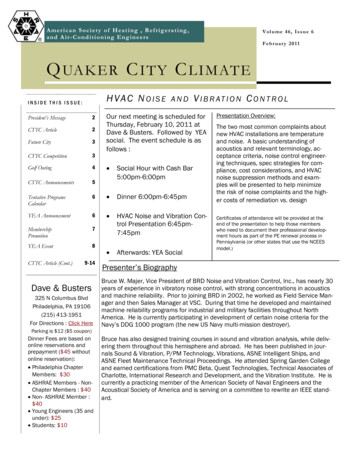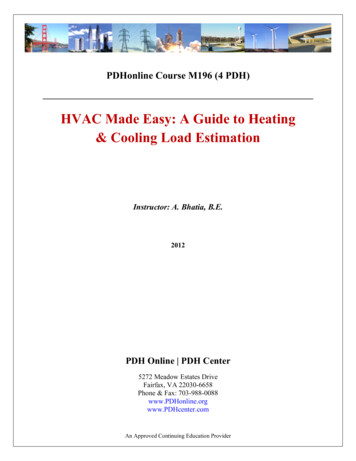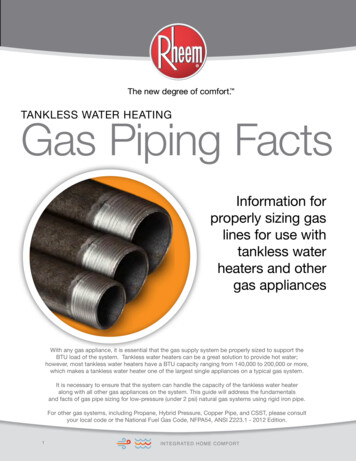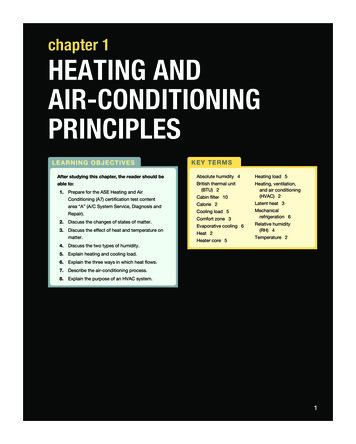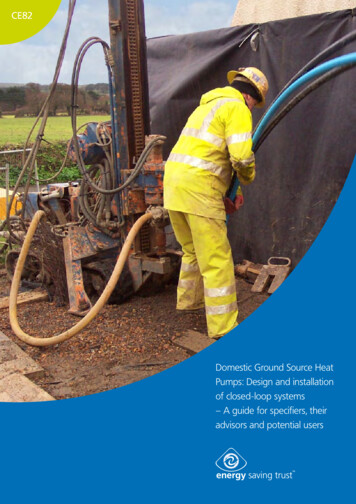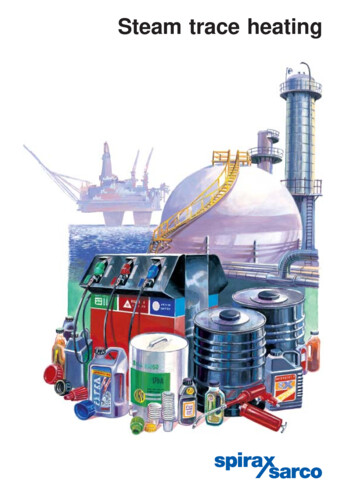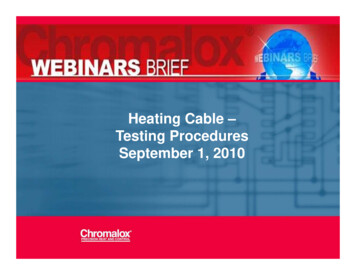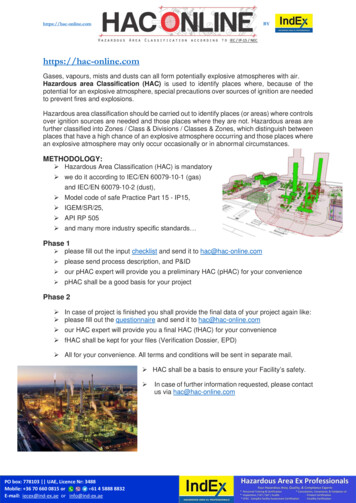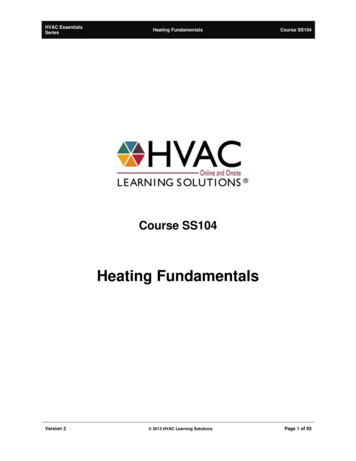
Transcription
HVAC EssentialsSeriesHeating FundamentalsCourse SS104 Course SS104Heating FundamentalsVersion 2 2013 HVAC Learning SolutionsPage 1 of 93
HVAC EssentialsSeriesHeating FundamentalsCourse SS104Table of Contents1.Gas Heating Systems. 41.1.1.2.1.3.Natural Convection Systems . 5Forced Air Systems . 6Furnace Systems. 72.Review Questions – Gas Heating Systems . 113.Sources of Fuel . 144.Combustion Theory . 164.1.4.2.4.3.5.Characteristics of Fuel Gases . 195.1.5.2.5.3.5.4.5.5.5.6.6.Composition of Gases . 16Natural Gas . 17Liquefied Petroleum Gas . 18Boiling Point . 19Specific Gravity. 19Ignition Temperature . 20Units of Measurement . 22Fuel Delivery and Operating Pressures . 24Gas Pressure Measurements . 26Combustion Air . 286.1.6.2.6.3.Oxygen . 28Excess Air . 28The Combustion Process of Natural Gas . 287.Review Questions – Fuel/Combustion . 338.Combustion Air and Venting . 418.1.8.2.8.3.8.4.8.5.9.Understanding Combustion and Venting . 41Bringing Combustion Air into the Home. 42Venting Systems for In-Home Heating Systems . 47Types of Gas Vents for Natural Draft Systems . 50Vent Connections . 52Review Questions – Combustion Air & Venting . 5310. Furnace Sequence of Operation . 57Version 2 2012 HVAC Learning SolutionsPage 2 of 93
HVAC EssentialsSeriesHeating FundamentalsCourse SS10410.1. Forced Air Furnaces . 5710.2. Basic Forced Air Furnace Components . 5810.3. Basic Furnace Sequence of Operation . 6011. Review Questions – Gas Furnace Sequence of Operation. 6412. Furnace Ratings . 6612.1.12.2.12.3.12.4.Capacity Rating . 66The Manufacturer’s DATA (Model) Plate . 66Choosing the Right Furnace Size . 67Efficiency Ratings of Furnaces . 6813. Review Questions – Furnace Ratings . 7014. Heating with Oil . 7214.1. Characteristics of Fuel Oil . 7214.2. Fuel Delivery & Measurements. 7414.3. The Oil Delivery System . 7614.4. The Combustion Process . 7714.5. The Role of Excess Air . 7814.6. The Relationship of Excess Air, Smoke, and Efficiency . 7914.7. Combustion Air Requirements . 8014.8. Venting of Oil Furnaces . 8014.9. Furnace Components . 8314.10. Oil Furnace Sequence of Operation . 8615. Review Questions – Heating with Oil . 8816. Glossary of Terms . 92Version 2 2012 HVAC Learning SolutionsPage 3 of 93
HVAC EssentialsSeriesHeating FundamentalsCourse SS1041. Gas Heating SystemsThis chapter is an introduction to gas heating systems. It is designed to give you an insight into the typesof fuels and configurations of heating systems used in the HVAC industry. We will group residentialhome heating systems into the following categories. Forced air Hydronic forced air Hydronic (radiant) Heat pump forced air Direct / RadiantForced air systems are the most popular systems in residential home heating. They use heated airdelivered to the home through ductwork. There are also many different ways to heat the air in a forced airsystem. Gas forced air combusts a fuel inside of a heat exchanger. Hydronic forced air uses a radiator style coil filled with water heated by the combustion of a fuel. Heat pumps use a radiator style coil filled with hot gas refrigerant. Electric furnaces use an electric strip.Hydronic systems use water instead of air to heat the home through baseboards or radiators. This isusually called radiant heat. Hydronic systems are often thought of as more comfortable than forced air.The radiators or baseboards are usually warm, giving off heat even when the boiler is off. The heatdoesn't appear to turn on and off to the homeowner as with forced air systems. One disadvantage is thatthe ability to filter and cool the air has been lost, without installing another complete system.Version 2 2012 HVAC Learning SolutionsPage 4 of 93
HVAC EssentialsSeriesHeating FundamentalsCourse SS104Direct systems simply use a baseboard with an electric element (strip) in them, which gets warm, even hotto the touch when electricity is applied, similar to the element in a toaster, except on a larger scale andusually higher voltage. Four settings or a thermostat can centrally or individually control them.1.1.Natural Convection SystemsTo better understand forced air heating, let’s go back to convectionheating. Even before the "furnace," this form of heating can beunderstood by imagining a cast iron stove in the middle of a smallcabin. The heat conducted through the metal walls of the stovewarms the air in the room. The lighter, hotter air in the room risesand causes the cooler, heavier air in the room to fall. This is anexample of natural convection. As long as enough heat wasgenerated, the cabin stays warm.In a home, with many different rooms, ductwork is needed to get thehot air to all the rooms and bring the cold air back to the furnace.Originally, this "furnace" was nothing more than a very large castiron stove with a box built around it and very large ductwork with few bends (restrictions), coming in andout of the box. This allowed the lighter heated air to rise to the home and the heavier cooler air to fallback down to the furnace. These furnaces were very large and were called "gravity" by their function, or"octopus" by their looks, furnaces. This is also a called natural convection.Version 2 2012 HVAC Learning SolutionsPage 5 of 93
HVAC EssentialsSeries1.2.Heating FundamentalsCourse SS104Forced Air SystemsAt this point we will not talk about what was used to heat the air, just how the heated air is delivered tothe home. So far all we know is that when cooler air is passed across a hot surface, the air is warmed.When an electric motor and a blower wheel are added to the heating box, you have "forced convection,"or forced air heating. Now the air can be moved to and from the home faster and more efficiently througha smaller furnace and smaller ductwork, compared to a natural convection system.Supply Air:The flow ofconditioned airfrom the furnaceto the home.Return Air:The flow ofunconditioned airfrom the homeinto the furnace.On convection systems, the ducts were very large so they would not slow down the natural convectionprocess. On forced air systems they are smaller and can direct the air all the way across the room forbetter circulation and more comfort.It may help to think of a forced air furnace as a box with two basic components. A "heating section" responsible for heating the air that is passed across it. A "blower section" responsible for moving the air to and from the home.HeatingSectionBlowerSectionVersion 2 2012 HVAC Learning SolutionsPage 6 of 93
HVAC EssentialsSeries1.3.Heating FundamentalsCourse SS104Furnace SystemsNow that we have a basic understanding of what a forced air system is, let’s look at the different styles.1.3.1. UpflowThe unit is in the vertical position. Thecooler, un-conditioned return air entersthrough the sides or the bottom, and theheated, conditioned supply air leaves thetop of the unit. HeatingSectionThe air flows through the furnace in anupward direction. The blower is below the heat exchanger. This furnace is also called a highboy. This application is typically found inBlowerSectionbasements and closets.1.3.2. The Lowboy FurnaceAnother style of up flow furnace wascalled the lowboy. This up flowfurnace actually sits horizontally. Air still flows upward out of one sideof the furnace, but the return airenters the top of the furnace also onthe other side. The airflow throughthe furnace is in a horseshoe pattern. Return air enters into the top of theblower section, and supply air leavesthe top of the heat exchanger section.Version 2 2012 HVAC Learning SolutionsPage 7 of 93
HVAC EssentialsSeriesHeating Fundamentals The blower is next to the heat exchanger. This application is typically found in basements.1.3.3. Course SS104Down Flow (Counter Flow)The unit is in the vertical position. You willnotice that the blower is above the heat exchanger.The cooler, unconditioned return air entersthrough the top of the unit and the heated,BlowerSectionconditioned supply air leaves the bottom of theunit. The air flows through the furnace in adownward direction. HeatingSectionThis application is typically found in closets.1.3.4.Horizontal Flow FurnaceThe unit is in the horizontal position, and the blower isnext to the heat exchanger. The cooler, unconditionedreturn air enters one side of the unit, and theheated, conditioned supply air leaves the otherside. The manufacturer determines thedirection of flow from side to side. The airflows through the furnace from one side to theother; it can go either way depending on thedesign of the furnace.The horizontal flow application is typicallyfound in attics and crawlspaces.HeatingSectionVersion 2 2012 HVAC Learning SolutionsBlowerSectionPage 8 of 93
HVAC EssentialsSeries1.3.5.Heating FundamentalsCourse SS104Hydronic Heating SystemsA hydronic system uses water to transfer the heat to the home instead of air as in a forced air furnace.Hydronic systems are usually referred to as "boilers," even though the water in a hydronic boiler does notboil when it is working properly. The heated water circulates through pipes from the boiler to the home,where radiators, baseboards, or air handlers release the heat into the home. The cooler water, as a result ofreleasing heat into the home, then returns to the boiler to be reheated.Version 2 2012 HVAC Learning SolutionsPage 9 of 93
HVAC EssentialsSeries1.3.6.Heating FundamentalsCourse SS104Direct SystemsThese baseboards heat the home by convection in the same manner as a copper fin tube. Instead of heatedwater, an electric element is used to heat the tube and fins. These work well in buildings and areas wherefuel is not available or space is not available for a furnace or boiler. They are very popular in condos.Version 2 2012 HVAC Learning SolutionsPage 10 of 93
HVAC EssentialsSeriesHeating FundamentalsCourse SS1042. Review Questions – Gas Heating Systems1) The ability of hot air to rise and cool air to fall is an example of what?a) Conductionb) Natural Convectionc) Forced Air Convectiond) Natural Conduction2) Adding an electric motor and a blower wheel to move air is called what?a) Forced Convectionb) Conductionc) Forced Conductiond) Natural Convection3) The flow of un
HVAC Essentials Series Heating Fundamentals Course SS104 Version 2 2012 HVAC Learning Solutions Page 6 of 93 1.2. Forced Air Systems At this point we will not talk about what was used to heat the air, just how the heated air is delivered to the home. So far all we know is that when cooler air is passed across a hot surface, the air is warmed.



